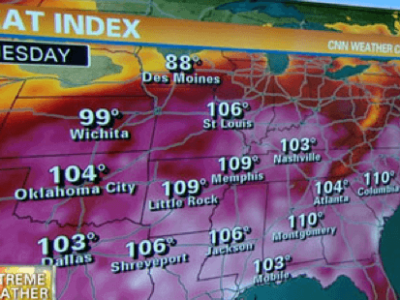If you’re planning a trip to the beach or an outdoor party this week you may want to reschedule or move your plans indoors. In fact,you definitely should. Dangerously hot temperatures are predicted to sweep through the heartland of the country with temperatures as high as 110 degrees or more and are expected to persist until next week, reports CNN.
The excessive heat caused the death of one person, a 51-year-old male in Granite City, Illinois whose air conditioning was not working. The heat wave has caused several power outages leaving many homes without relief from the heat.
As of this past weekend a record-breaking heat wave has slowly crept into the Midwest and South who have been hit the hardest amidst heat warnings in 23 states and the District of Columbia.
With temperatures alone reaching the 100 mark the mixture of heat and humidity has caused the heat index, how hot it actually feels, soaring into the high triple digits in parts of the South. Oklahoma City, Oklahoma, is experiencing its 14th straight day of unbearable temperatures, with the hottest of the hot taking over Mississippi and Tennessee, where the heat index could skyrocket to 116.
Other areas located outside the highest temperatured areas are still at risk. States included in the heat advisory are Connecticut, Delaware, Kansas, Louisiana, Maryland, New Jersey, New York, North Carolina, Ohio, Pennsylvania, South Carolina, Texas and Virginia. The northeast's hottest temperatures are expected to break mid-week but many areas are in danger of a cold front moving in from the north that has the potential to cause severely dangerous thunderstorms.
Doctors are warning that everyone needs to be wary of how dangerous the heat can be, claiming that extreme temperatures like this have the potential to inflict long-term brain damage. According to CNN, forecasters say people should limit outdoor activity during the hottest portions of the day, wear lightweight clothing, drink plenty of water and be watchful for signs of heat exhaustion, which include heavy sweating, pale and clammy skin, weak pulse, fainting and vomiting.



















